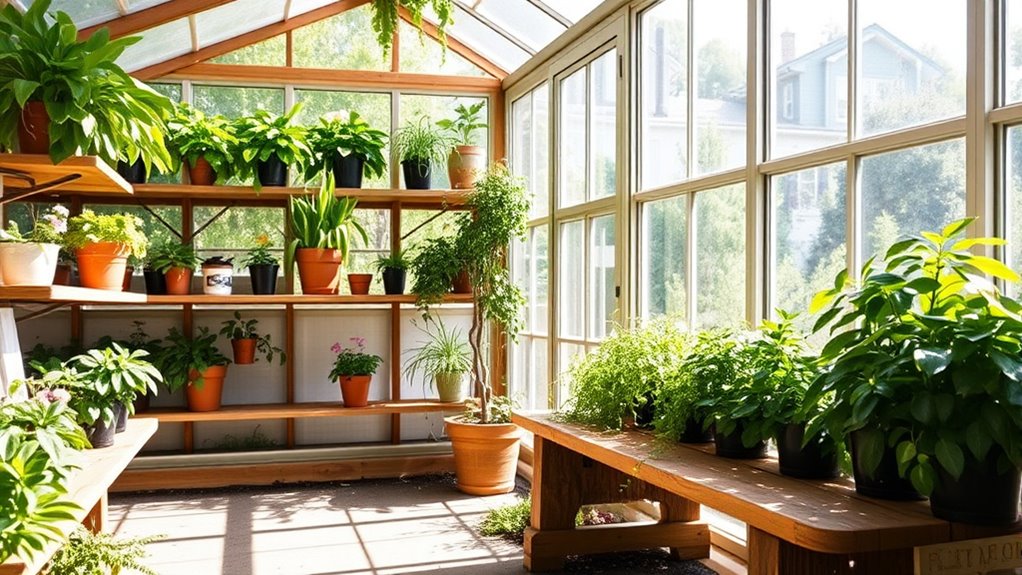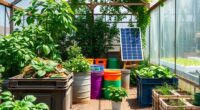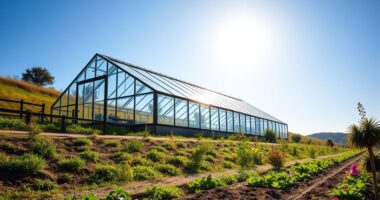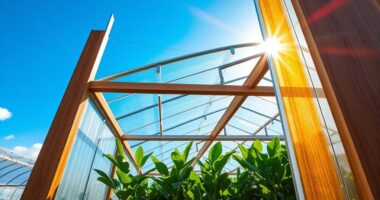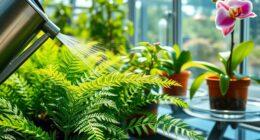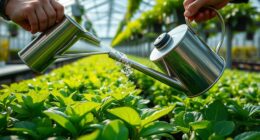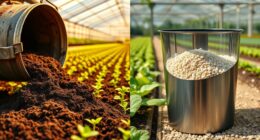Adding shelves and benches to your greenhouse helps you stay organized and makes plant care easier. You can select from various shelving options, including metal, wood, and wire, based on your needs. Choose moisture-resistant materials for durability. Design your benches for ergonomic use and clear pathways, maximizing your growing area. Integrating shelves with irrigation systems guarantees your plants receive the right water. There’s much more to contemplate to optimize your greenhouse setup and growth.
Key Takeaways
- Adding shelves enhances organization by providing dedicated spaces for tools and plants, reducing clutter and improving accessibility.
- Benches should be designed between 28 to 36 inches in height for ergonomic use, allowing comfortable plant maintenance.
- Choose moisture-resistant materials like galvanized metal or treated wood to ensure durability and ease of maintenance in humid greenhouse environments.
- Integrate shelving with irrigation systems for efficient watering, utilizing options like drip systems or flexible hoses for adaptability.
- Plan for clear pathways between benches and shelves to facilitate navigation and accommodate future changes in plant types or layouts.
Benefits of Adding Shelves and Benches

When you add shelves and benches to your greenhouse, you’ll discover a range of benefits that enhance both organization and plant care.
With dedicated spaces for tools, seeds, and containers, you’ll reduce clutter and improve accessibility, making it easier to maintain a clean environment essential for plant health. Proper organization means less time searching for supplies, increasing your efficiency.
Elevating plants on shelves allows for ideal sunlight exposure and better growth, while benches provide a comfortable working height, reducing strain. You’ll also prevent issues like waterlogging by keeping plants off the floor.
Types of Greenhouse Shelving Options
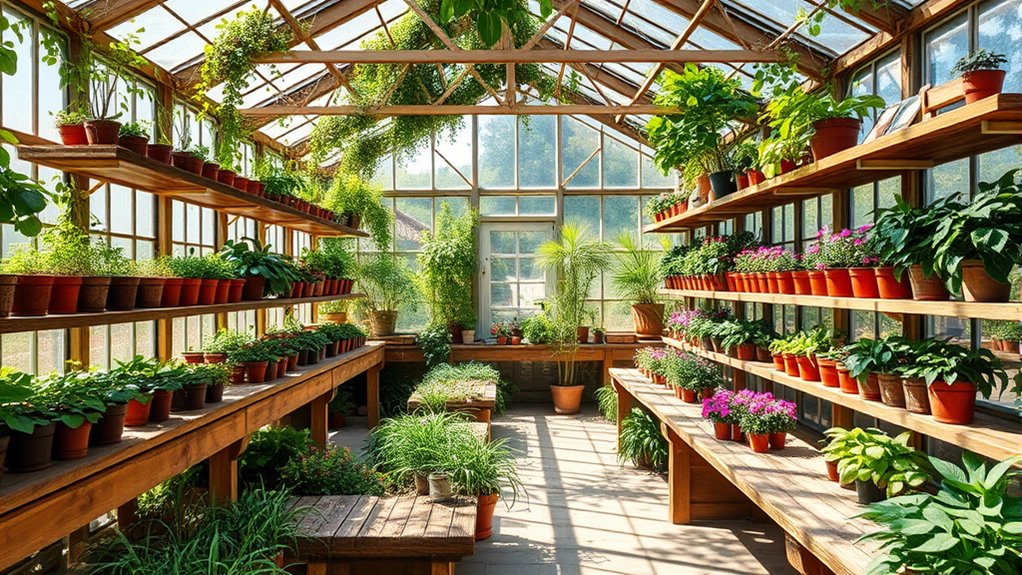
Whether you’re looking to maximize space or improve plant health, choosing the right shelving for your greenhouse can make a significant difference.
Here are some popular options to evaluate:
- Galvanized Metal Shelves: Durable and rust-proof, perfect for humid environments while adding a modern touch.
- Wooden Shelves: Provides a natural aesthetic and rustic charm, ideal for medium to heavy gardening needs, though they require maintenance.
- Wire Shelving: Excellent for airflow and ventilation, preventing mold growth and allowing sunlight to reach lower plants.
Each shelving type has its unique advantages, so reflect on your specific needs and preferences.
Choosing the Right Materials for Your Shelving
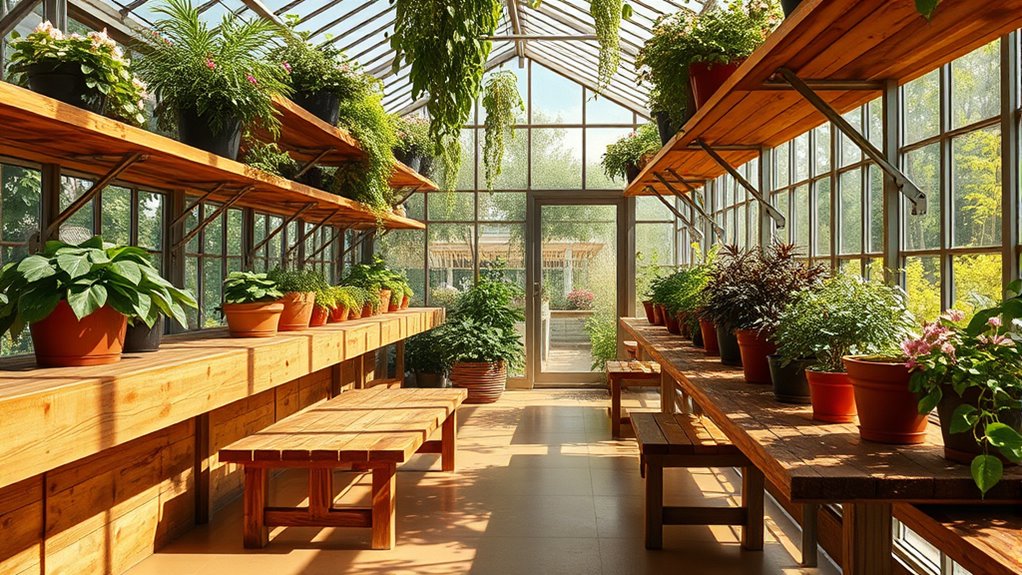
Selecting the right materials for your greenhouse shelving can greatly impact both its functionality and aesthetic appeal.
For durability, consider moisture-resistant woods like mahogany or cedar, which offer a traditional look but can be pricier. Metal shelves, on the other hand, provide sturdiness and excellent air circulation while being more cost-effective.
Consider moisture-resistant woods like mahogany or cedar for a classic look, or opt for cost-effective metal shelves for durability and air circulation.
If you’re aiming for sustainability, polyethylene or plastic is a great choice, often made from recycled materials and resistant to moisture.
Additionally, materials like glass and wire mesh allow maximum sunlight penetration and drainage, enhancing plant growth.
Whichever material you choose, make certain it aligns with your greenhouse’s style, is easy to maintain, and supports your plants’ needs for air and light.
Key Design Considerations for Greenhouse Benches
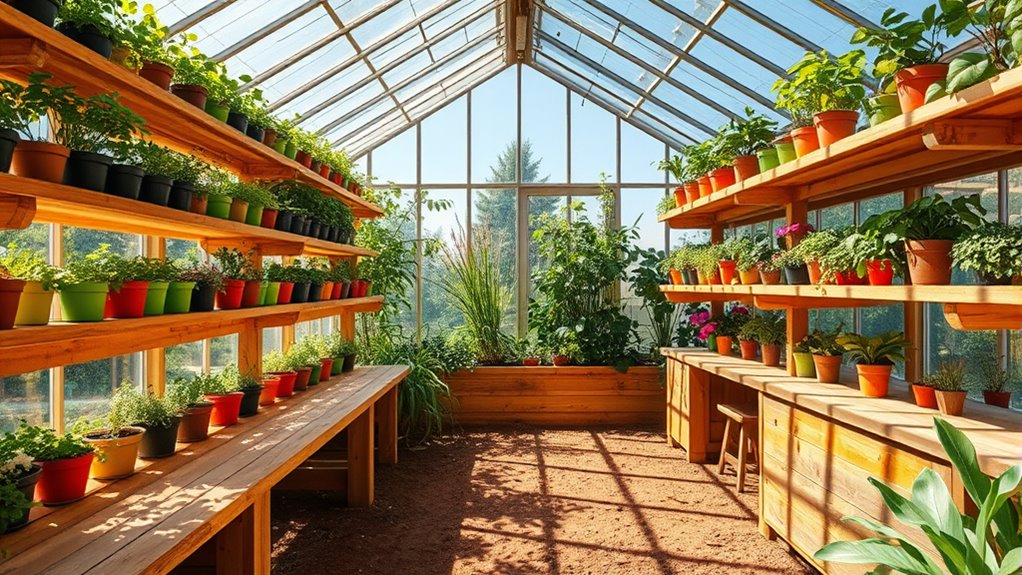
Designing the perfect greenhouse benches requires careful consideration of several key factors to verify they meet your specific needs.
Start by evaluating your greenhouse’s primary use, as this directly affects the design.
Here are three essential considerations:
- Space Optimization: Confirm easy navigation while maximizing growing space.
- Height and Accessibility: Design benches between 28 to 36 inches for ergonomic use, keeping pathways clear for carts or wheelchairs.
- Future Adaptability: Plan for potential changes in layout or plant types to enhance versatility.
Integrating Shelves With Greenhouse Systems
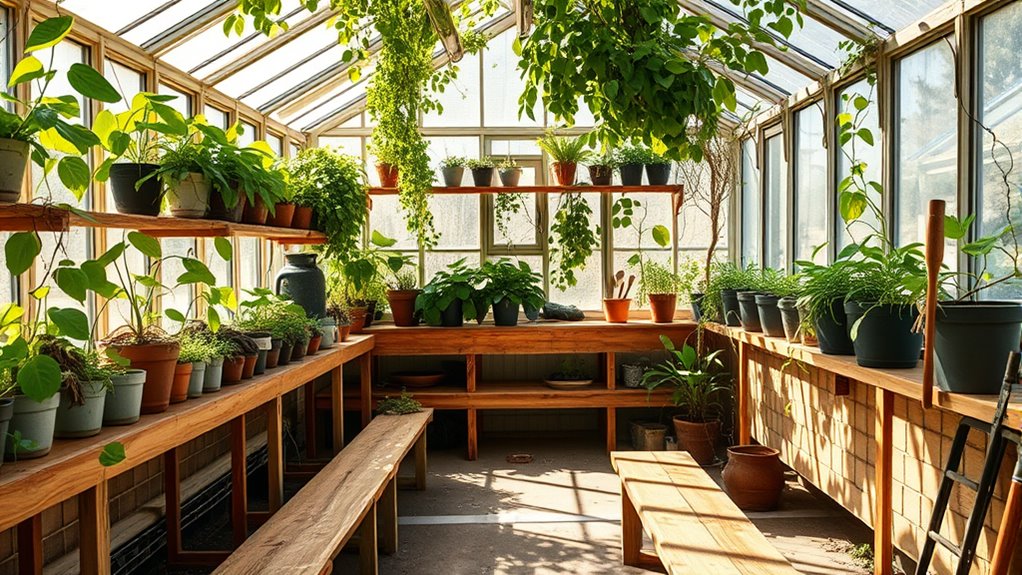
When integrating shelves into your greenhouse, consider how they’ll work with your irrigation system.
You’ll want to guarantee easy access for watering and maintenance, while also supporting environmental controls like ventilation and heating.
This way, your shelving becomes an efficient part of your overall greenhouse system.
Irrigation System Compatibility
Integrating an effective irrigation system with your greenhouse shelving not only maximizes space but also assures your plants receive consistent moisture.
Here are some key considerations for compatibility:
- Choose the Right System: Opt for drip irrigation for precise water delivery or misting systems for gentle, even watering.
- Flexible Design: Use rolling shelves and flexible hoses to make certain your irrigation setup adapts as you move plants.
- Optimal Placement: Position irrigation lines along the shelves to guarantee uniform water distribution without blocking access.
Environmental Control Integration
To create an ideal growing environment, you can seamlessly integrate shelving with various environmental control systems in your greenhouse.
By incorporating heating systems like root-zone heating, your shelves maintain optimal root temperatures. Humidity management systems work hand-in-hand with shelves to prevent disease while promoting healthy growth. You can also integrate lighting systems for precise control over plant exposure.
Additionally, consider CO2 enrichment and ventilation systems to enhance air circulation and temperature regulation.
Modular shelving designs allow you to customize setups that adapt to your greenhouse’s specific needs. With automation and smart controllers, you’ll improve efficiency and reduce labor costs while maximizing plant quality and yield.
Maintenance Tips for Long-Lasting Shelving
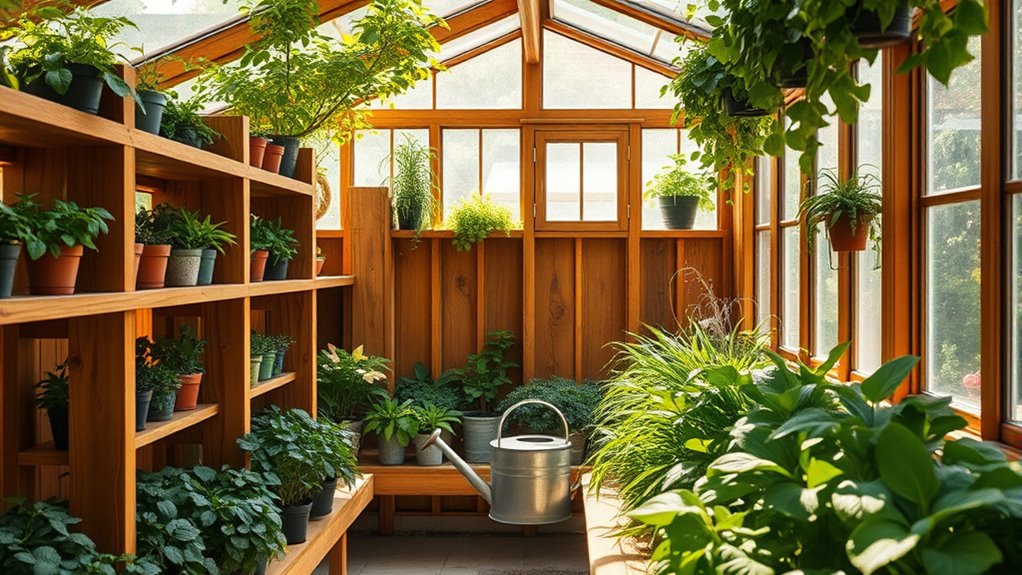
While you might be enthusiastic to fill your greenhouse with plants, maintaining your shelves is essential for longevity.
Regular upkeep will prevent issues and guarantee your shelving remains functional. Here are some tips to keep in mind:
- Regular Wipe-Downs: Clean metal and wire shelves often to avoid rust buildup.
- Inspect for Pests: Regularly check for pests and remove any debris that could attract them.
- Reseal Wooden Shelves: Periodically reseal or repaint wooden shelves to keep them fresh and sturdy.
Maximizing Efficiency and Productivity in Your Greenhouse
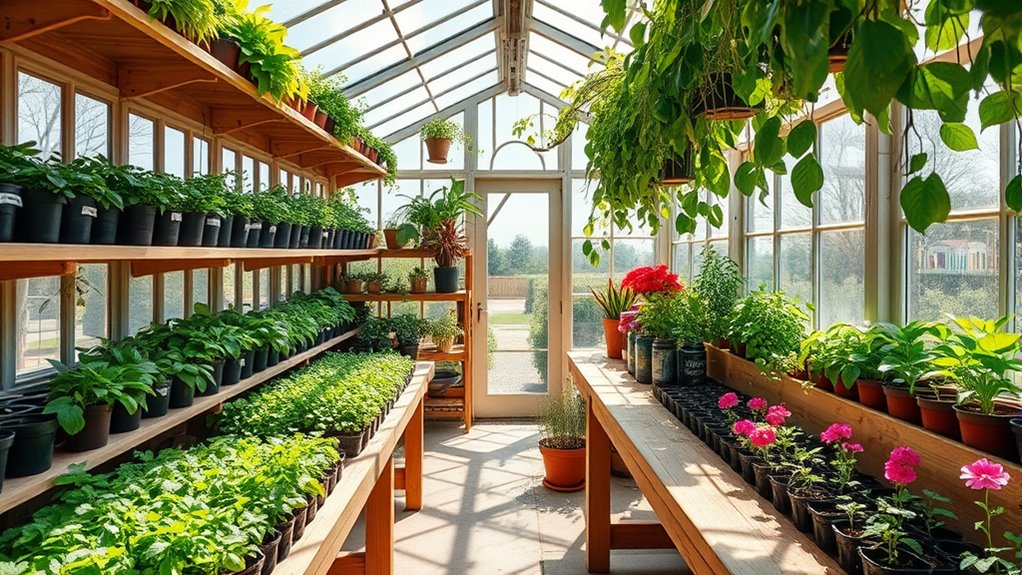
Maximizing efficiency and productivity in your greenhouse isn’t just about cramming in more plants; it’s about optimizing every aspect of your setup.
Start by tuning control systems, ensuring timers and thermostats are properly set to minimize energy waste. Upgrade to high-efficiency motors and keep fans clean to boost their effectiveness.
Insulating perimeters and using thermal screens can greatly cut heating costs. Space optimization techniques like vertical growing and compact plants will help you utilize every inch.
Enhance your lighting by switching to LEDs and employing precision controls for better results. Additionally, incorporating shelves and benches can help you organize your plants and tools, making it easier to access everything you need while maximizing space.
Finally, monitor energy consumption and adjust your crop scheduling to streamline production. These strategies will create a more efficient, productive greenhouse environment.
Frequently Asked Questions
How Much Weight Can These Shelves Safely Hold?
When considering weight capacity, you’ll find that shelves typically hold between 44 lbs (20 kg) and 220 lbs (100 kg).
It’s essential to check the specifications of the particular shelf you’re interested in, as this can vary widely.
Take care to distribute weight evenly to prevent any potential collapse.
Can I Build My Own Greenhouse Shelving?
Building your own greenhouse shelving is as rewarding as planting a seed and watching it grow.
You can absolutely create shelves tailored to your needs by using materials like wood, metal, or even repurposed pallets.
Just follow some simple steps—cut, assemble, and level them properly.
With a bit of creativity and effort, you’ll have sturdy, functional shelves that enhance your greenhouse and make your gardening experience even more enjoyable.
What Is the Best Height for Greenhouse Benches?
The best height for greenhouse benches typically ranges from 28 to 36 inches.
You’ll want to choose a height that feels comfortable for you, considering whether you’ll be standing or sitting while working.
If you’re growing taller plants, opt for lower benches to guarantee you have enough headroom.
Ergonomics play an essential role, so make certain the benches prevent excessive bending or straining to enhance your overall gardening experience.
How Do I Prevent Rust on Metal Shelves?
To prevent pesky rust on metal shelves, prioritize proper protection.
Start with zinc coatings or hot-dip galvanization for superior shielding. Regularly inspect your shelves, ensuring you spot signs of deterioration early.
Maintain moisture management by improving airflow and cleaning consistently. Consider using rust-resistant alloys or even plastic alternatives for a lasting solution.
Are There Specific Plants That Require Special Shelving?
Yes, certain plants do require special shelving to thrive.
For instance, orchids need slatted shelves for air circulation and humidity, while succulents prefer well-draining surfaces.
Tropical plants do best with insulated shelving to maintain warmth and moisture.
If you’re growing seedlings, adjustable shelving helps create controlled environments for ideal growth.
Vines, on the other hand, benefit from vertical shelving or trellises to support their climbing nature.
Choose materials and designs that suit your plants’ needs!
Conclusion
Adding shelves and benches to your greenhouse is a game-changer. Not only do they help you organize your plants, but they also maximize your available space, making it easier to work efficiently. By choosing the right materials and designs, you’ll create a setup that lasts. Remember, a well-organized greenhouse helps you cultivate not just plants, but also productivity. So, get your hands dirty and start building—your plants will thank you for it!
